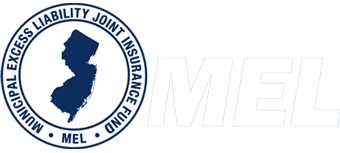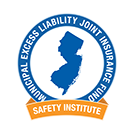The MEL has numerous training and education programs and resources available related to safety and risk management offered through the MEL Safety Institute. The information below is just an overview. Please visit the website to view the MSI Catalog and lists of current in-person and online courses, videos, and other resources.
Making Safety a Priority
The long term reduction of employee accidents has been a real success story. Over the past 40 years, the on-the-job fatality rate for all types of employers has been reduced 80%. However, employee accidents are still a serious concern in government. The average accident rate for all NJ governmental employers is higher than any other major category tracked by the NJ Department of Labor.
Management can reduce accident rates over time. It is management that establishes the priorities and sets an example. There are five management strategies that make a substantial difference in any organization’s safety record.
- Monitor Safety Performance. Managers communicate their priorities by what they monitor. In a recent study, employers where top management closely follows the safety record average 85% fewer accidents than employers where top management is not aware of the accident rate. Of course, simply monitoring the accident rate does not reduce accidents by itself. However, where managers are aware of their safety performance, they are far more likely to make sure the safety program is being conducted properly.
- Require all personnel to complete a safety orientation and periodic refresher training. Organizations where all workers are up to date on their safety training average 46% fewer reportable accidents.
- Discuss safety with employees at the start of each shift – Organizations where supervisors and crew leaders discuss safety with their associates each morning average 54% fewer accidents. Managers and supervisors have the responsibility to make sure each operation is properly planned and that each employee is reminded of the critical safety procedures required for each day’s activities. A safety program is like a campaign. You need to consistently communicate the message and keep it fresh.
- Empower employee involvement in the safety program. Safety must include the grass roots and cannot be solely top down. Management should empower the workforce so that everyone feels free to question something that appears unsafe, and everyone looks out for each other. Every employee has the right to stop an operation if something does not seem right. This involves a profound change in management/employee relations.
- Become directly involved in accident investigations. When we say “participate”, we do not mean simply read the reports – we mean get involved – go to the scene where the accident occurred and drill down until the real causes are identified.
The single most important thing any official can do is to place the safety program on the discussion agenda each month and request management report on the program’s status. Officials are responsible to establish priorities. The management team and workforce will adjust their priorities based on what officials decide to monitor.
The (employer name) will provide a safe and healthy work environment and shall comply with all applicable safety and health regulations. The (employer entity) is equally concerned about the safety of the public. Consistent with this policy, employees will receive periodic safety training and will be provided with appropriate safety equipment. Employees are responsible for observing safety rules and using available safety devices including personal protective equipment. Failure to do so constitutes grounds for disciplinary action. Any unsafe condition, practice, procedure or act must be immediately reported to the supervisor or department head. Any on-the-job accident or accident involving (employer entity) facilities, equipment or motor vehicles must also be immediately reported. The (employer name) has appointed a Safety Committee that meets on a regular basis to recommend solutions to safety problems. Employees are encouraged to discuss safety concerns with their Safety Committee representative.
Click here to view other model policies.
Each year, approximately 1 percent of all office employees suffer a disabling on the job accident. While this is only one quarter the rate for other occupations, it is still serious enough that every office workers must be provided with safety training and be included in the employee safety program.
The MEL provides an on-line office safety orientation at no charge to the members. This program is also available through the MEL’s learning management system so that members can record who has taken the program.
Almost half of office related accidents involve slips and falls. The MEL’s video Smart Moves to Avoid Falling Down addresses that issue.
Many administrative and managerial employees are also injured in vehicle accidents while traveling on appointments. All personnel who operate vehicles (either employer or employee-owned) on business must be included in the vehicle safety program including driver license checks and periodic training.
The MEL Safety Insitute offers in-person and online training related to safety and has safety briefings, bulletins and other resources.
For more information about workplace safety visit the U.S. Department of Labor – Occupational Safety and Health Administration Website (OSHA).
Approximately 45% of employee accidents in municipalities occur in public works including utilities. Work on roads and around heavy equipment is inherently dangerous. The award-winning video, Don’t Get Caught in the Crush Zone shows the precautions that must be taken to prevent these accidents.
The two largest causes of DPW injuries are body mechanics (49%) and fall downs (19%). The videos Back Pain, Stop and Think and Smart Moves to Avoid Falling Down address these issues. Another especially relevant video is Driving During Emergencies and Natural Disasters. Any governmental agency may download and use these videos.
Research has shown that the accident rate can be reduced by reminding employees of basic precautions at the beginning of each day’s operations. Shift Briefings on a wide variety of safety issues ranging from seasonal to specific categories of work are also available.
To view these and other MSI videos, bulletins and shift briefings please visit the MEL Safety Institute Website and click on the MSI Toolkit.
- No Tolerance (Employee Practices) on-demand program available on the MSI LMS System. Click here for the 2025 flyer.
- Workplace Harassment & Discrimination video is available on the MSI LMS System. Click here for the 2023 flyer.
- Click here to view a new publically available video presentation Harassment in the Workplace for Managers and Supervisors – Panel Discussion Format
Resource Guides
The Americans with Disabilities Act (ADA) ensures access to the built environment for people with disabilities. The ADA Standards establish design requirements for the construction and alteration of facilities subject to the law. These enforceable standards apply to places of public accommodation, commercial facilities, and state and local government facilities.
Click here for MEL Bulletin on website compliance.
For more information about ADA visit the United States Access Board or use these resources below.
Municipal Excess Liability Joint Insurance Fund
9 Campus Drive, Suite 216,
Parsippany, NJ 07054
Phone: 201.881.7632
Fax: 201.881.7633
mel@permainc.com
© Copyright 2025 | Municipal Excess Liability Joint Insurance Fund | All rights reserved


